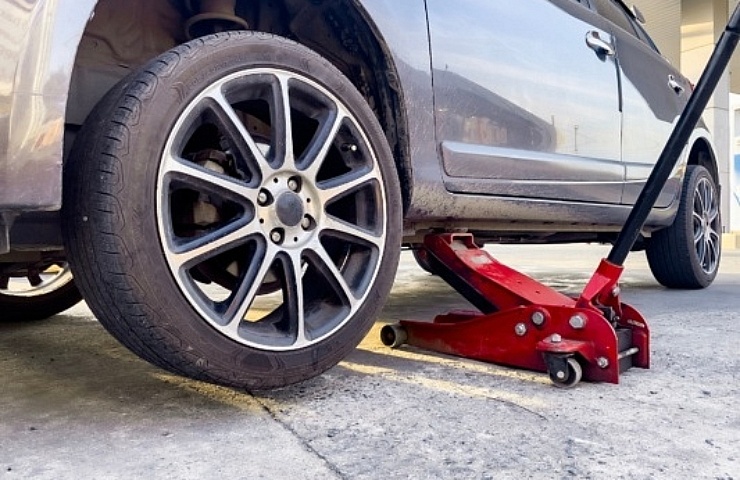Floor Jacks
Hydraulic floor jacks are the most common way to lift a vehicle. They come in a variety of sizes, heights, and lifting capacities. They use a lever connected to a hydraulic oil piston and a lifting arm with a saddle that fits onto your vehicle’s lifting point or frame. This arm and piston ride on a wheeled trolley, allowing the jack to stay positioned correctly under the vehicle as it is lifted.
The height of the jack is critical. For example, consider a low-profile floor jack if you have a sports car. Low-profile jacks can slide under front spoilers and the sides of lowered cars. The arm’s length will determine how high a jack can lift a vehicle. The longer the arm, the higher it can go.
A jack’s lifting capacity is also important for safely lifting a vehicle. Most cars weigh about 3,000 to 4,000 pounds, so a lifting capacity of 1.5 to two tons is commonly a good choice. For trucks, a lifting capacity of three to seven tons is recommended.
A steel floor jack weighs significantly more than an aluminum model. If you plan to carry the jack from spot to spot often, an aluminum floor jack could be a backsaver. A three-ton steel floor jack might weigh over 100 pounds, while an aluminum unit might squeak by under 50 pounds. Surprisingly, the prices of the two styles are similar.
Shop now for floor jacksScissor Jacks

Some after-market scissor jacks come with an electric motor that turns the screw mechanism. The car’s DC power plug powers the motor. This is helpful for those with limited mobility or strength.
Shop now for scissor jacksBottle Jacks

Hi-Lift Jacks
This specialty jack is designed for the most demanding off-road situations. While lightweight, it has a lifting capacity of up to 7,000 pounds and a high lifting range. Hi-lift jacks are versatile and can be used for pushing, pulling, winching, and clamping. A hi-lift jack is the best choice if you are driving in desert canyons, tropical jungles, or remote farmlands.
Exhaust Jack

Safety First with Jack Stands
Safety is your top concern. When working on your vehicle, never support your ride with only the jack. Follow these two essential rules.
Always use jack stands to support the vehicle safely.
Over time, hydraulic floor jacks can fail due to wear on the hydraulic components. These failures are rarely immediate and catastrophic. The problem emerges slowly, causing the jack to lower the lifting arm over time. This slow descent can go unnoticed until it is too late. Remember, if you are on your back in a tight space, it is not easy to quickly get out of the way.
If positioned correctly on its lifting points, jack stands can firmly support a vehicle. An excellent habit for using jack stands is to rock or push on the vehicle after it is placed on jack stands to ensure it is firmly seated before going under the vehicle. If only one side of the vehicle is lifted, use wheel chocks on the wheels on the ground and set the emergency brake.
Shop now for jack standsAlways lift a vehicle on level ground.
Lifting a car or truck on an angle or a slanted driveway will shift its center of gravity, possibly causing it to tip.
Raise and lower your vehicle very slowly. This will give you time to see any problems before they happen. Lowering a vehicle too fast can lead to situations that can damage a car’s suspension or other components.
Read this: How to Jack Up a Car
Finally, always use the proper jack lifting points on your vehicle. Most vehicles are lifted from reinforced areas on the rocker panel. Check the owner’s manual if you are unsure of your vehicle’s recommended lifting point.
Shop now for vehicle jacks







